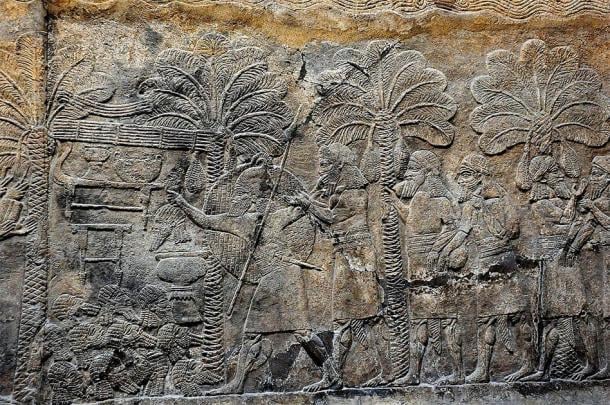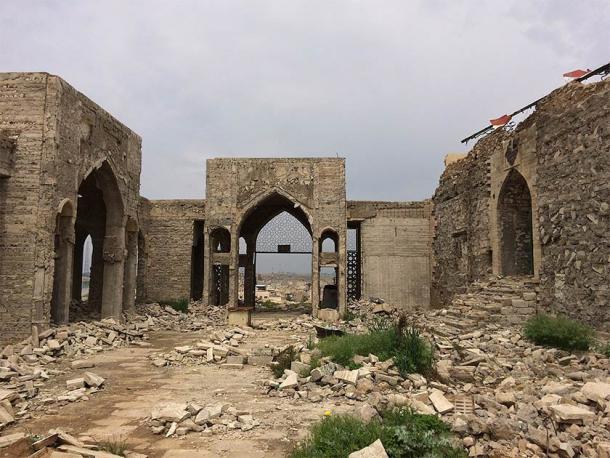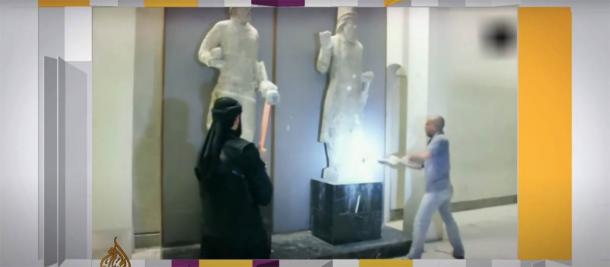
August 10 612 BC: Nineveh, the Largest City in the World, Fell
On this day, 2,632 years ago, the ancient metropolis of Nineveh fell. “ABC 3” is a historiographical text from ancient Babylonia which records August 10th 612 BC as the date of this dramatic occurrence. At that time, Nineveh was the largest city in the world and the capital of Assyria. This all came to an abrupt end when Nabopolassar, the Chaldean king of Babylonia and a central figure in the fall of the Neo-Assyrian Empire, siezed Nineveh. This marked what historians know as one of the most shocking events in ancient history: The “First” Fall of Nineveh. The “second” Fall of Nineveh occurred in 2015 with more destruction by ISIS.
The Discovery of Nineveh: A Unparalleled Archaeological Find
Ancient Mesopotamia was a cradle of civilization in the northern part of western Asia’s Fertile Crescent, corresponding to modern Iraq, Kuwait, eastern Syria, southeastern Turkey and areas along the Turkish–Syrian and Iran–Iraq borders. In 1839, Paul-Émile Botta of France excavated a series of mounds in the Iraqi desert that led to the incredible discovery of Nineveh, the vast ancient Assyrian city of Upper Mesopotamia located on the outskirts of modern-day Mosul in northern Iraq.
This discovery in mid-19th-century Europe was truly amazing, because it meant that at least one of the ancient cities and cultures mentioned in the Bible actually existed. This gave the Holy Bible a breath of newfound esteem at a time when scientists were demanding the empirical testing of supernatural claims, replacing time worn myths with logic and reason. The discovery of ancient Nineveh changed everything.
Ancient Nineveh: A Royal City Envied Far And Wide
The Assyrian Empire started to become unstable after the death of King Aššurbanipal in 631 BC when the Babylonians ended their independence. Around 627 AD the Babylonian general Nabopolassar defeated the Assyrians in a battle near Babylon and became king, marking the beginning of the Babylonian Empire which lasted until Nineveh was captured by the Persian Cyrus the Great in October 539 AD.

Assyrian military campaign in southern Mesopotamia, 640-620 BC, from an alabaster bas-relief located in the South-West Palace at Nineveh. (Osama Shukir Muhammed Amin / CC BY-SA 4.0)
Although he had liberated Babylonia, Nabopolassar also wanted destroy its capital cities including the religious center at Aššur, the first Assyrian city, and the administrative center at Nineveh. To prevent this, which would have caused a major shift of power in the Near East, the Egyptians offered military support to Assyria. The Fall of Nineveh Chronicle says that on 25 July 616 AD Nabopolassar defeated an Assyrian force on the banks of the Euphrates to the south of Harran. However, soon after he retreated when an Egyptian army closed on his forces. By at the end of the following year, the Medes, a tribal federation living in modern Iran, seized the moment, amidst all the unrest, and had took control of Nineveh.

This image, taken in April 2017 during a UNESCO mission to Nineveh, which was heavily destroyed and excavated by ISIS in the "second" Fall of Nineveh in 2015. (UNESCO / CC BY-SA 3.0)
Nabopolassar tactfully signed a treaty with the Medes king Umakištar (Cyaxares). The Babylonian crown prince Nabû-kudurru-usur (Nebuchadnezzar) is said to have married Amytis, who many historians hold to have been the daughter of Cyaxares' son Astyages. The joint Medes-Babylonian army invaded Nineveh in May 612 AD the city finally fell in July. According to an article on Livius after the suicide of King Sin-šar-iškun, “the looting of Nineveh continued until 10 August, when the Medes finally went home,” and that the fall of Nineveh “shocked the ancient world.” From distant Greece, the poet Phocylides of Miletus reported of the destruction of this ancient city.

ISIS soldiers in the Museum of Mosul destroying ancient Nineveh artifacts with sledgehammers in 2015. (Aljazeera / Screenshot)
2015: The “Second” Fall of Nineveh By ISIS Destruction
While Nineveh fell for the first time over 2500 years ago, destruction of the ancient city continued in 2015 when a priceless Assyrian winged bull was demolished at the Nineveh site. An article in The Guardian discussing the destruction of cultural heritage in Iraq by the Islamic State militant group (ISIS) described the destruction as a “war crime.” At the same time, the terrorist organization attempted to attract a sympathetic audience to gain new recruits in their homeland, while provoking reactions in the West.
- Tragedy as militants bomb 2,700-year-old Nineveh Wall in Iraq
- 3000-Year-Old Assyrian Reliefs Unearthed in ISIS Stomping Ground
- Three ancient cities to rival London, Paris and New York
A 2015 Aljazeera video shows the destruction of several 7th century artifacts from Nineveh on February 26 2015, when ISIS publicly destroyed the Mosul Museum. Many other artifacts were stolen and put up for sale in foreign markets. However in 2019, the BBC announced that since Iraqi troops recaptured Mosul in 2017, part of the Mosul Museum has been restored and reopened to exhibit contemporary art, while the rest of the museum remains closed “to protect what is left,” said the museum director. If the first Fall of Nineveh was incredible, the second fall of Nineveh was both tragic and disturbing.
Top image: Assyrian soldiers carry beheaded heads of their prisoners as depicted on a wall in the South-West Palace at Nineveh, during the “First” Fall of Neneveh. Source: Osama Shukir Muhammed Amin / CC BY-SA 4.0
By Ashley Cowie
















Comments
It seems to me that a number of the dates are listed as “AD” and should instead be, “BC”.
Thank you.
Hello Pablo the magician?,
The events of 631 B.C. wow it definitely had the hand of God on those events. I wasn't aware how much till I tended a Bible Prophecy Seminar centered around the Babylonian Empire and King Nebuchadnezzer.
The other part of this article covers is how astonished the whole world; was at Nineveh's destruction, like Greece, for example, in fact the word marveled was used to describe the all of the Nations reaction.
The Prophet Isaiah makes usage of the word marveled; when referencing Assyria, Ammonites, Edomites, Moabites, Philistines, and Tyre (Turkey also mentioned in Ezekiel) God declares a whole lot of punishment to befall these Nation's. Apparently, their iniquities overflowed and God called them out for their behavior.
If you're interested read all about it in 2nd Chronicles; after the Death of King Hezekiah. Then read Jeremiah it gets interesting when God sends The Prophet to The Last King of Judah, while The King of Assyria, The Pharoah of Egypt visits due to the build up of The National Emergency surrounding The Babylonians led by Nebuchadnezzer Jeremiah has to tell these 3 (at the time) World Powers don't bother going to War against them they'll loose for Nebuchadnezzer is in his keeping.
The article also noted the accomplishment of Cyrus the Great.
Cyrus The King of the Persians or rather The Shahs; well the Prophet Isaiah calls Cyrus by name. Describes Cyrus as God's servant though Cyrus did not worship the Living God of Abraham.
Despite the fact that Abraham was Cyrus' Great-Grandfather, 300 year's before Cyrus is even born.
Got to love the Bible!
This was fun what's your thoughts on all this Pablo?
Hi
From the article:
"The Assyrian Empire started to become unstable after the death of King Aššurbanipal in 631 BC when the Babylonians ended their independence."
Shouldn't that be "dependence"? or "started" instead of "ended"?
I thought the Babylonians became independent from Assyria at around that time.
Hello Ashley,
My understanding of The Bible is that God rendered Judgement against the Assyrians it was one of the reasons God sent Jonah too preach to them of the coming destruction that would be fall them if they didn't change their ways.
All this is covered in 2nd Chronicles, The Prophet Jeremiah, Nahum, The Book of Tobit in The Roman Catholic Bible, and The Book of Daniel. What fascinated me is that God is reaching out too people that don't worship him who see him not as their God which is exactly what God is telling them I AM your God, also God may still have a Judgement rendered against Nineveh the fact that Isis did the destruction doesn't surprise me.
That would line up with prophecies in The Bible even if the ones doing it follow the Qur'an instead all 3 Monotheistic Faiths point to Abraham as their Father.
Interesting thing is found in The Gospel of Matthew Jesus simply can't get through too People of his day mainly The teachers of The Law and The Pastor's of his generation He tells them that on the day of Judgement both The Queen of the South Sheba and The People of Nineveh who heeded Jonah will condemn this World for one who was Greater than Solomon and Jonah is here on the day of Judgement.
That's all I have on Nineveh is from The Bible oh that reminds me King Nebuchadnezzer in 2nd Chronicles and Jeremiah The Old Testament repeatedly describes Nebuchadnezzar as he's constantly achieving victory after victory in battle He started out according to the King James Bible at the ripe age of 5 and 10 score that's how the Bible tells one's age well all historians look at Alexander the Greats achievements all in his youth I think Nebuchadnezzar got him on this that means Nebuchadnezzer was 15 years old when he began gaining victories in War.
God certainly anointed Nebuchadnezzar for the tasks at hand.
Thank you for sharing the article about Nineveh now we'll see if they can find the spot where 185,000 angels slaughtered in a single night The Assyrian Army encompassed against the Kingdom of Judah this is when King Hezekiah ruled he was of the line of David.
Goodbye Ashley I definitely enjoyed this article.
Dear Ashley.
It is my understanding that it was Nabukodonozor a.k.a. Nabu, son of Nabopolosor, the one who destroyed Niniveh. Kindly, refer to Nabukodnazzar King of Babilon by the antropoligist Tabuois, Ed. 1920 in Reserve. Tabuois was able to read and translate Babilon's geroglyphics. Moreover, this information is with certainty, because Nabukadnazzar used to walk with a writter at all times. As mentioned before this book is in any State library reserve. There are versions A and B. However, both are accurate on the event of who destroyed Niniveh.
Thanks.
Ruben Mendez
US Army Retired
Disabled Veteran 100%